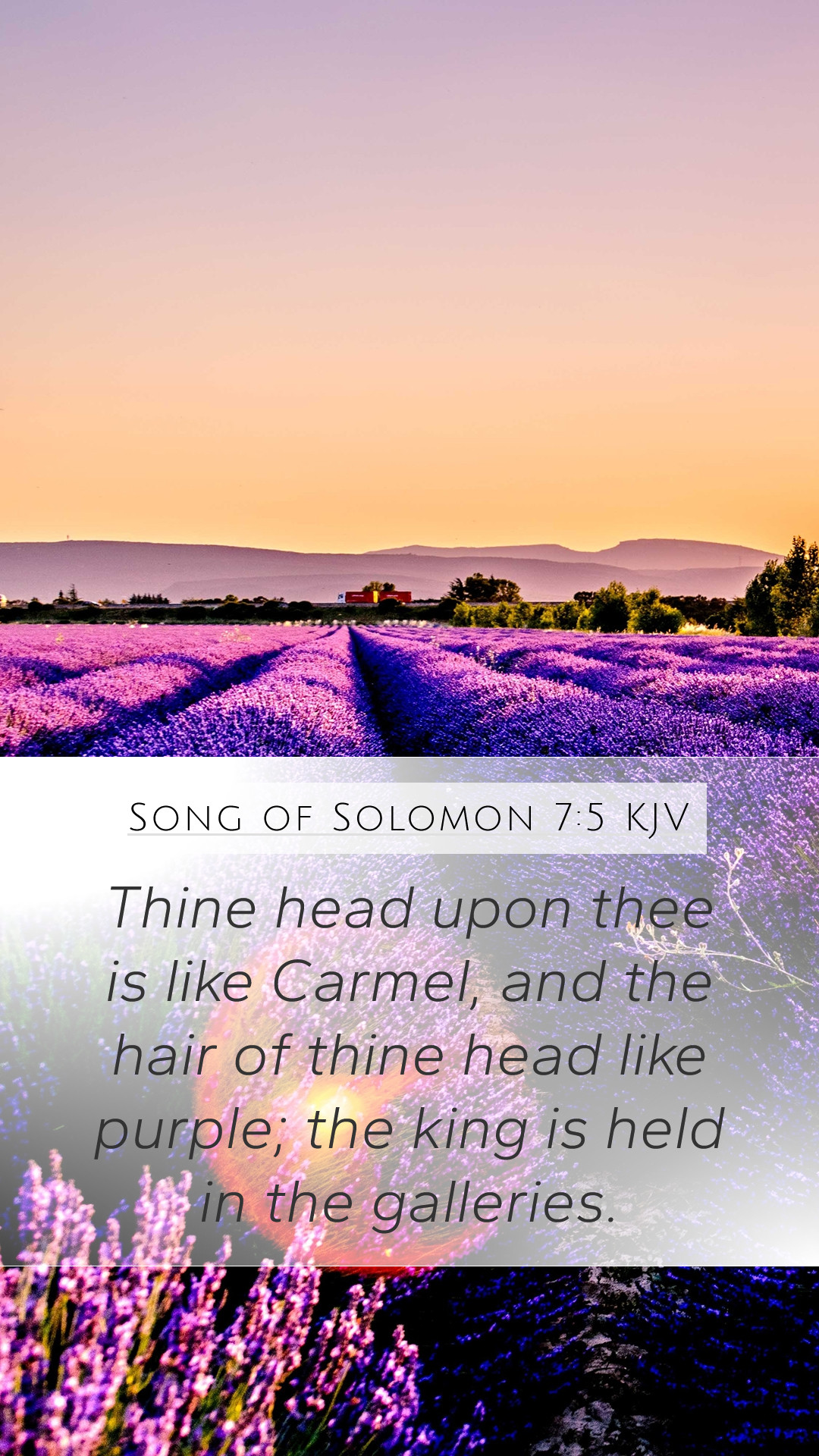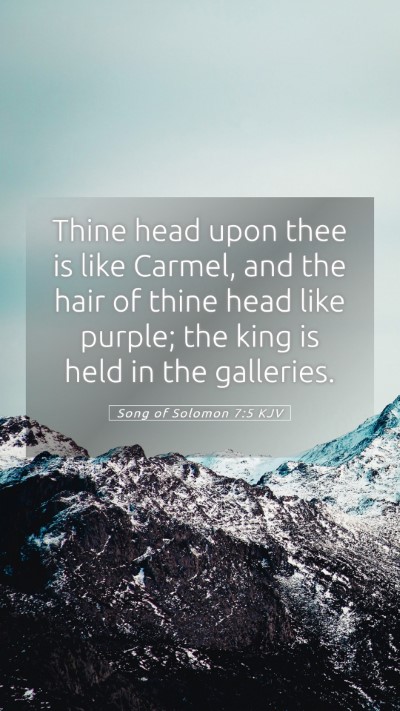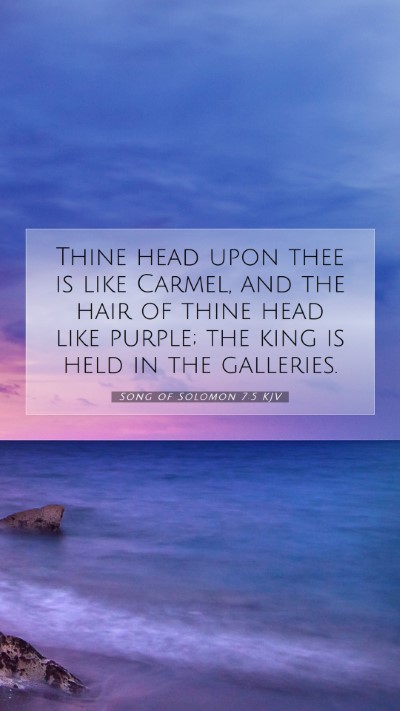Old Testament
Genesis Exodus Leviticus Numbers Deuteronomy Joshua Judges Ruth 1 Samuel 2 Samuel 1 Kings 2 Kings 1 Chronicles 2 Chronicles Ezra Nehemiah Esther Job Psalms Proverbs Ecclesiastes Song of Solomon Isaiah Jeremiah Lamentations Ezekiel Daniel Hosea Joel Amos Obadiah Jonah Micah Nahum Habakkuk Zephaniah Haggai Zechariah MalachiSong of Solomon 7:5 Meaning
What is the meaning of Song of Solomon 7:5?
Thine head upon thee is like Carmel, and the hair of thine head like purple; the king is held in the galleries.
Song of Solomon 7:5 Bible Verse Meaning
Understanding Song of Solomon 7:5
In this detailed exploration of Song of Solomon 7:5, we combine insights from public domain commentaries including those of Matthew Henry, Albert Barnes, and Adam Clarke. This verse, which reads, "Thine head upon thee is like Carmel, and the hair of thine head like purple; the king is held in the galleries," portrays profound beauty and love, as well as a rich, symbolic meaning worthy of exploration.
Verse Analysis
This verse is part of a poetic and romantic exchange that celebrates the beauty and allure of the beloved. Here, the speaker draws comparisons that highlight the unique beauty of the person described.
- Carmel: This mountain is significant in biblical history as a place of beauty and grandeur. The comparison implies that the beloved’s head (symbolizing authority and elegance) is majestic and stands out like Carmel.
- Hair like purple: Purple was historically a color associated with royalty and richness. This description emphasizes the illustrious nature of the beloved’s hair, suggesting it has a regal quality.
- King in the galleries: The imagery suggests that the beloved possesses a charm that captivates even the highest authorities, indicating that her beauty transcends ordinary experience.
Commentary Insights
The insights from the respective commentaries shed light on the meanings associated with this verse:
- Matthew Henry: He emphasizes the idea that the beauty of the beloved reflects divine artistry. The mention of Carmel indicates that her charm is both natural and pure, while the royal imagery of her hair illustrates not only her beauty but also the respect and admiration she evokes.
- Albert Barnes: Barnes points out that the language is rich in metaphor and emphasizes the wonder of love’s expression. He notes that the reference to being held in galleries signifies admiration from all, urging readers to appreciate the communal and societal admiration for true beauty.
- Adam Clarke: Clarke adds depth by examining the cultural significance of hair and beauty in ancient times. He discusses how both physical and moral qualities are intertwined in the text, suggesting that the beloved represents an ideal of beauty that is both external and internal.
Thematic Exploration
This verse touches on several significant themes relevant to understanding Scripture:
- Beauty and Admiration: The text explores how beauty can inspire admiration and even reverence, illustrating the powerful effect of aesthetic qualities in relationships.
- Divine Design: The allusions to nature and royalty signify that true beauty is a mark of divine creativity, inviting reflection on God's handiwork.
- Romantic Love: Within the context of romantic love, this verse underscores the joys and exaltations associated with physical attraction and emotional bonding.
Related Scriptures
To gain further understanding of this verse, it can be illuminating to consider the following biblical cross-references:
- Proverbs 31:30: "Charm is deceitful, and beauty is vain, but a woman who fears the LORD is to be praised."
- 1 Samuel 16:7: "For the LORD sees not as man sees: man looks on the outward appearance, but the LORD looks on the heart."
- Song of Solomon 4:7: "Thou art all fair, my love; there is no spot in thee."
Application for Bible Study
This verse can serve as a focal point for various bible study topics:
- Online Bible study: Engage with the themes of beauty and love within the context of relationships.
- Bible study guides: Explore how the symbolism in Song of Solomon can apply to contemporary understandings of love and beauty.
- Bible study lessons: Discuss the nature of divinely inspired beauty and how it manifests in human relationships.
Conclusion
As we study Song of Solomon 7:5, we recognize the multifaceted dimensions of beauty and love depicted in the poetic language. By integrating insights from established commentaries and considering the broader themes, we deepen our Bible verse understanding and enrich our spiritual exploration. This verse serves not only as an artistic representation of love but also as an invitation to appreciate the divine in human relationships.
Further Study
For those seeking additional Bible study resources, consider delving into books that focus on the Song of Solomon for a comprehensive analysis of its themes and language. This ongoing exploration encourages individuals and groups alike to reflect on the beauty of love as depicted in Scripture.


